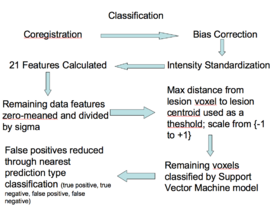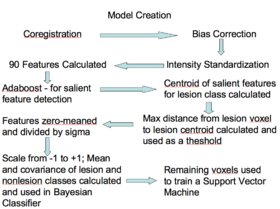Difference between revisions of "AHM2009:Mind"
Hjbockholt (talk | contribs) |
Hjbockholt (talk | contribs) |
||
| Line 22: | Line 22: | ||
* Illustrate the components and workflow of the pipeline using your own data | * Illustrate the components and workflow of the pipeline using your own data | ||
{| | {| | ||
| − | |[[Image:Sle_wmls_model_creation.png|thumb|280px | + | |[[Image:Sle_wmls_model_creation.png|thumb|280px]] |
| − | |[[Image:Sle_wmls_model_generation.png|thumb|280px | + | |[[Image:Sle_wmls_model_generation.png|thumb|280px]] |
|} | |} | ||
Revision as of 05:32, 8 January 2009
Home < AHM2009:Mind
MIND Roadmap Project
Overview
- What problem does the pipeline solve, and who is the targeted user?
- The pipeline attempts to solve the problem of segmenting white matter lusions in lupus. The capability is aimed at clinical researchers.
- How does the pipeline compare to state of the art
- The state of the art is a work in progress in N-SLE. There are many approaches that attempt to solve lesion classification in Multiple Sclerosis. Some of these approaches are automated or semi-automated; however, all automatic approaches suffer a lack of a gold standard. It is difficult for humans manual raters to agree on fuzzy boundaries across different image constrasts (e.g., T1, T2, FLAIR).
A good example of the lack of a pipeline was the approach taken at the 2008 MICCAI Conference MS Lesion Segmentation Challenge this past May in the form of a grant challenge in segmentation. Several groups, including this DBP, competed by first being providing training data-sets with two manual labellings, approaches were judged on an application set naive to each classification approach.
Detailed Information about the Pipeline
- Illustrate the components and workflow of the pipeline using your own data
- Demonstrate parameters/steps that need to be adjusted using someone else's data
Software & documentation
Team
- DBP: Affiliation & logo
- Core 1: Affiliation & logo
- Core 2: Affiliation & logo
- Contact: H. Jeremy Bockholt, hjbockholt@mrn.org
Outreach
- Publication Links to the PubDB.
- H. J. Bockholt, V. A. Magnotta, M. Scully, C. Gasparovic, B. Davis, K. Pohl, R. Whitaker, S. Pieper, C. Roldan, R. Jung, R. Hayek, W. Sibbitt, J. Sharrar, P. Pellegrino, R. Kikinis. A novel automated method for classification of white matter lesions in systemic lupus erythematosus. Presented at the 38th annual meeting of the Society for Neuroscience, Washingto, DC, 15 – 19 November 2008
- Scully M., Magnotta V., Gasparovic C., Pelligrimo P., Feis D., Bockholt H.J. 3D Segmentation In The Clinic: A Grand Challenge II at MICCAI 2008 - MS Lesion Segmentation. IJ - 2008 MICCAI Workshop - MS Lesion Segmentation. Available http://grand-challenge2008.bigr.nl/proceedings/pdfs/msls08/282_Scully.pdf
- 2008 SFN conference outreach activity
- 2009 AAN conference outreach activity
References
Adaboost and Support Vector Machines for White Matter Lesion Segmentation in MR Images. Quddus A, Fieguth P, Basir O. PAMI Lab, Department of Electrical and Computer Engineering, University of Waterloo, Waterloo, ON, Canada. Conf Proc IEEE Eng Med Biol Soc. 2005;1:463-6. http://www.ncbi.nlm.nih.gov/pubmed/17282216
Architecture for an Artificial Immune System Steven A. Hofmeyr, Stephanie Forrest Evolutionary Computation Winter 2000, Vol. 8, No. 4, Pages 443-473 http://www.mitpressjournals.org/doi/abs/10.1162/106365600568257
Automated segmentation of white matter lesions in 3D brain MR images, using multivariate pattern classification Zhiqiang Lao; Dinggang Shen; Jawad, A.; Karacali, B.; Dengfeng Liu; Melhem, E.R.; Bryan, R.N.; Davatzikos, C. Biomedical Imaging: Nano to Macro, 2006. 3rd IEEE International Symposium on Volume , Issue , 6-9 April 2006 Page(s): 307 - 310 http://ieeexplore.ieee.org/Xplore/login.jsp?url=/iel5/10818/34114/01624914.pdf?temp=x
Automatic Segmentation of MS Lesions Using a Contextual Model for the MICCAI Grand Challenge Jonathan H. Morra, Zhuowen Tu, Arthur W. Toga, Paul M. Thompson IJ - 2008 MICCAI Workshop - MS Lesion Segmentation http://www.midasjournal.org/browse/publication/280


